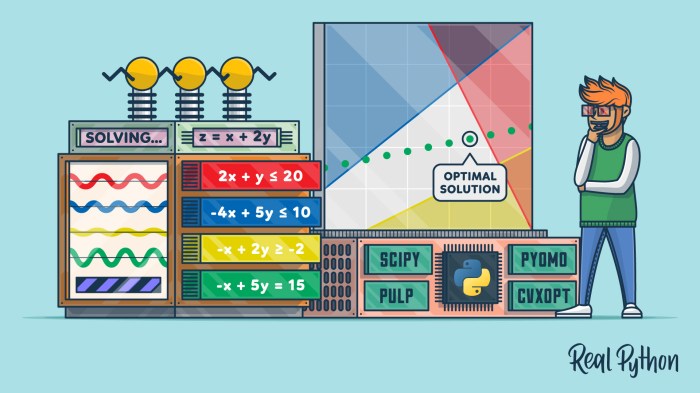Linear programming to produce an aggregate plan – Linear programming emerges as a powerful tool for aggregate planning, enabling businesses to optimize production schedules, minimize costs, and maximize efficiency. This technique empowers decision-makers with a structured approach to align production with demand, ensuring optimal resource allocation and enhanced profitability.
Delving into the realm of aggregate planning, we explore its significance in operations management and the diverse strategies employed to balance supply and demand. Real-world examples illustrate the practical applications of aggregate planning across various industries, showcasing its impact on production efficiency and overall business performance.
Linear Programming Overview

Linear programming is a mathematical technique used to optimize decision-making in situations where there are multiple competing objectives and constraints. It involves finding the optimal solution to a system of linear equations that represent the problem.
Linear programming problems can be classified into two main types: maximization problems, where the goal is to find the maximum value of a given objective function, and minimization problems, where the goal is to find the minimum value of the objective function.
Linear programming has a wide range of applications in various fields, including operations management, finance, transportation, and manufacturing.
Aggregate Planning
Aggregate planning is a medium-term planning process that determines the production levels and workforce requirements for a given period, typically ranging from three to eighteen months.
The goal of aggregate planning is to meet customer demand while minimizing costs and ensuring smooth operations.
There are different types of aggregate planning strategies, including level production, chase demand, and mixed strategies.
Examples of aggregate planning can be found in various industries, such as manufacturing, retail, and healthcare.
Linear Programming Model for Aggregate Planning
A linear programming model for aggregate planning involves the following components:
- Decision variables:Production levels and workforce levels for each period.
- Objective function:Typically minimizes total production and inventory costs.
- Constraints:Capacity constraints, demand constraints, and workforce constraints.
Solving the linear programming model involves using optimization techniques to find the optimal values of the decision variables that minimize the objective function while satisfying the constraints.
Benefits of Using Linear Programming for Aggregate Planning, Linear programming to produce an aggregate plan
Linear programming offers several benefits for aggregate planning:
- Improved decision-making:Provides a structured approach to evaluating different planning options and making informed decisions.
- Optimized resource allocation:Helps allocate resources efficiently to meet demand while minimizing costs.
- Increased profitability:By optimizing production and inventory levels, linear programming can lead to increased profitability.
Challenges and Limitations
Linear programming for aggregate planning also has some challenges and limitations:
- Assumptions and simplifications:The model assumes linearity, which may not always be realistic in practice.
- Computational complexity:Solving large-scale linear programming models can be computationally intensive.
- Data availability:Accurate data on demand, capacity, and costs is crucial for effective planning.
Advanced Techniques
For large-scale aggregate planning problems, advanced techniques such as heuristic and metaheuristic algorithms can be used to find near-optimal solutions.
Heuristic algorithms, such as the Silver-Meal heuristic, provide quick and efficient solutions, while metaheuristic algorithms, such as genetic algorithms and simulated annealing, can find high-quality solutions for complex problems.
User Queries: Linear Programming To Produce An Aggregate Plan
What is the primary objective of using linear programming for aggregate planning?
Linear programming aims to optimize aggregate planning by minimizing production costs while meeting demand constraints and ensuring efficient resource utilization.
How does linear programming handle uncertainty in demand forecasting?
Linear programming models can incorporate probabilistic or fuzzy logic to account for uncertain demand, providing more realistic and robust aggregate plans.
What are the limitations of linear programming for aggregate planning?
Linear programming assumes linearity in relationships and may not be suitable for highly non-linear production systems. Additionally, it can be computationally intensive for large-scale problems.

